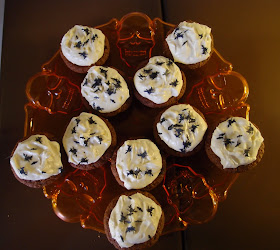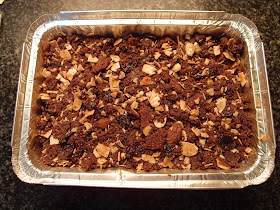Tonight is Samhain – or to use it’s more common name
nowadays – Halloween. The night marks a time when the "door"
to the Otherworld opens enough for the souls of the
dead, and other beings, to come into our world. Spooky, eh?
With all these
souls of the dead turning up unannounced, the chances are you’ll need some cake
to placate them. What better than some
spicy carrot cupcakes with lusciously thick cream cheese frosting?
Unlike many
carrot cakes this one doesn’t contain nuts or dried fruit, resulting in a
lighter than air sponge. It was
difficult to cut for a photo because the sponge just crumbled into fat juicy
crumbs. I rather like the witch who has
decided to embed herself in the frosting – she looks ever so comfortable!
I’m not really
one for Halloween and the commercialisation thereof, but when I saw the most
beautifully round, unblemished little pumpkin in my local supermarket – for just
£1 – I knew I had to have it. I would
rather eat my own feet than pumpkin so the only option was to turn my perfect
pumpkin into a little personality. So
here we are – my first ever attempt at pumpkin carving. Try as I might, I just couldn’t get him to
look evil – there are happy pumpkins, surely?
Ingredients
For the
cupcakes:
175g muscovado sugar
100g wholemeal self raising flour
100g self raising flour
1 teaspoon bicarbonate of soda
2 teaspoons mixed spice
1 orange – zest
150ml sunflower or any flavourless cooking oil – I used light olive oil (for baking and roasting)
2 eggs
200g carrots – grated (about 2 normal sized carrots)
1 tablespoon orange juice
100g wholemeal self raising flour
100g self raising flour
1 teaspoon bicarbonate of soda
2 teaspoons mixed spice
1 orange – zest
150ml sunflower or any flavourless cooking oil – I used light olive oil (for baking and roasting)
2 eggs
200g carrots – grated (about 2 normal sized carrots)
1 tablespoon orange juice
For the
frosting:
100g unsalted butter – at room temperature
300g cream cheese – at room temperature (I used Philly)
100g icing sugar
1 teaspoon vanilla extract
300g cream cheese – at room temperature (I used Philly)
100g icing sugar
1 teaspoon vanilla extract
To decorate: Sprinkles of your choice
Method
Preheat the oven to 180°C/fan oven 160°C/350°F/gas mark 4.
Line a 12 hole cupcake pan with paper cases.
Mix together the sugar, flours, bicarbonate of soda, mixed
spice and orange zest.
In a jug, measure out the oil and then add the eggs; whisk
lightly so they are combined.
Stir the oil into the dry mixture.
Stir in the grated carrot and orange juice.
Spoon into the paper cases – take care to be neat; it’s
tricky to spoon because of the carrot – the mix will want to slide off the spoon!
Bake for 20-25 minutes or until a skewer inserted into the
cakes comes out clean.
Leave to cool on a wire rack.
Now make the frosting: beat the butter until it is soft and
whippy.
Beat in the cream cheese, icing sugar and vanilla.
Spoon onto the cupcakes in generous dollops. This isn’t a frosting to do fancy piping
with!
Decorate as desired – I used witch, spider and bat
sprinkles.
Bask in the glory of the wonderful thing you have created.
Eat.



























